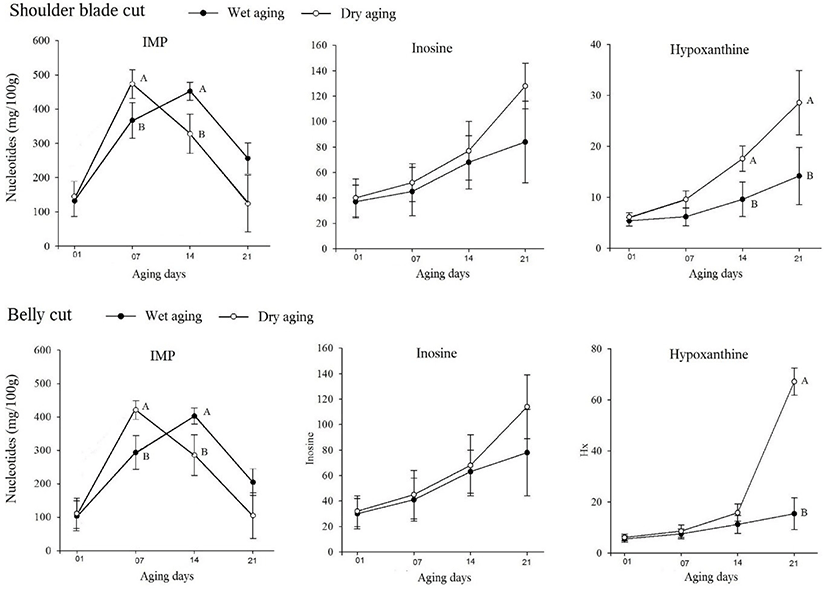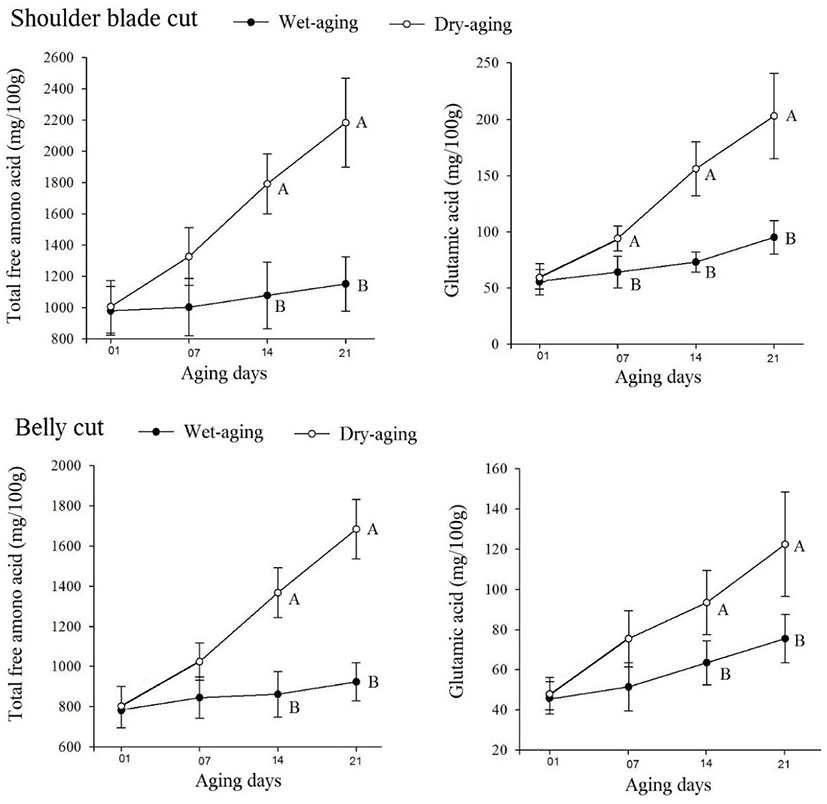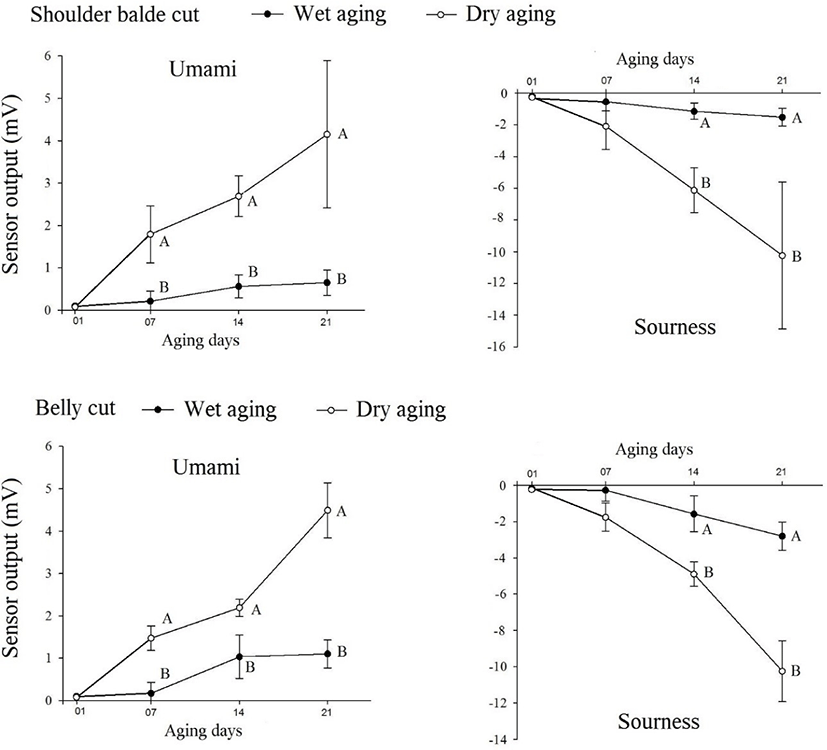Introduction
Pork is the world’s most consumed meat and its consumption increases annually. In Korea, among pork cuts, belly and shoulder blade cuts are the most popular cuts though their price is higher than other cuts. These two cuts are commonly used for traditional Korean meat cooking which is called ‘Gogi-gui’, because of their palatable taste. Recently, a variety of methods including aging and cooking have been developed to improve the taste of pork Gogi-gui.
Fresh meat often extends the aging period to make it taste better. It is now well known that postmortem aging is related to meat palatability attributes in terms of tenderness, juiciness and flavor because of a structural breakdown of muscle by proteases enzymes (Kim et al., 2016). The two most common forms of postmortem aging are dry-aging (without vacuum packed) and wet-aging (with vacuum packed) (Smith et al., 2008). Dry-aging is a traditional process related to increase the palatability particularly flavor perception, tenderness, marbling etc. of cut meats, and practiced by local meat processor for value added products to attract local consumers (Kim et al., 2017). Because dry-aging leads to concentration of major nutrients such as protein, fat, minerals etc., when the dry-aged meat is chewed, fat-like juicy materials are released which lead to increased flavor, umami and other sensory attributes (Campbell et al., 2001). Therefore, dry-aging meat is definitely a premium product for Gogi-gui restaurant in Korea.
Although dry-aging is well known to improve meat tenderness and flavor, however, most studies have been conducted on beef. In particular, very little research has been done on pork. Recently, a study on the effect of dry-aging of pork loin is reported (Lee et al., 2016), but pork loin cut is generally not used for Gogi-gui in Korea. For this reason, we reported earlier on the effect of the dry-aging of pork belly and shoulder blade cuts on meat quality attributes such as meat color, water-holding capacity, tenderness, lipid oxidation, and protein degradation (Hwang et al., 2018b). In this study, we investigated the changes in taste compounds and sensory characteristics of dry-aged pork belly and shoulder blade cuts during 21 days of aging. The nucleotides and free amino acids were investigated for taste compounds, and sensory characteristics were evaluated by electronic tongue system.
Materials and Methods
Ten belly and shoulder blade cuts produced from five pork carcasses were purchased at a commercial slaughterhouse at 24 h postmortem. The samples of the two pork cuts were divided into wet-aging (vacuum packed) treatment and dry-aging (without packed) treatment. Each treatment units was labelled as follows: SW (shoulder blade-wet aging), SD (shoulder blade-dry aging), BW (belly-wet aging), and BD (belly-dry aging). The samples were aged at 2°C in a cold room with a relative humidity of 80% for 21 days each, and the taste compounds and sensory characteristics were investigated every week.
Nucleotides were quantified by a modified method of Yang et al. (2002). Minced meat sample (5 g) was mixed with 20 mL of 0.5 M cold perchloric acid and homogenized for 1 min, and centrifuged at 3,000×g for 15 min at 4°C. The supernatant was filtered and the residuum was mixed with 10 mL of 0.5 M cold perchloric acid for another homogenizing. After filtering, the filtrate was adjusted to pH 6.0 by adding 5 M potassium hydroxide, and then centrifuged again in same conditions (3,000×g for 10 min at 4°C). Subsequently, the supernatant was marked up to 50 mL by adding 0.5 M perchloric acid (pH 6.0) and filtered through a 0.45 μm filteration membrane before analysis. Twenty microliters of the samples were injected in an Agilent 1100 HPLC system with Eclipse Plus C18 column (4.6×100 mm, 3.5 μm). Column temperature was set at 25°C and peaks were detected at 254 nm by a diode array detector (DAD). Mobile phase A (0.06 M K2HPO4, 0.04 M KH2PO4, pH 7) and mobile phase B (80% methanol, 20% Mili-Q water) were used as eluents. The elution program of Phase B was at 0 min (0%), 10 min (0%), 11 min (100%), 12 min (0%) and the program finally took a further 4 min to return to the initial conditions and stabilize. The flow rate of the mobile phase was kept at 1.2 mL/min with a total run time of 16 min. Identification and quantification of the nucleotides were evaluated by comparing the retention times and peak areas of samples with IMP (inosine monophosphate), inosine and hypoxanthine standards.
The preparation of sample for free amino acids determination was based on the Aristoy and Toldra (1991) with a slight modification. The meat samples 4 g were homogenized with 20 mL of 0.1 N HCl at 5°C for few seconds. After homogenizing, the samples were centrifuged at 3,000×g for 30 min at 4°C. The 300 μL extracted samples were mixed with 10 μL internal standard (Norvaline) and 690 μL acetonitil. The mixtures were allowed to stand 30 min at 4°C before centrifuging at 3,000×g for 15 min. Supernatant/sample was filtered through millipore HPLC filters (0.45 μm PVDF) before injection into the HPLC. Free amino acids were determined using an Agilent 1100 HPLC system, equipped with a robotic autosampler, and using a DAD. The samples were added with borate buffer and 0.5 μL sample was injected on an Eclipse Plus C18 column, 4.6×100 mm, 3.5 μm. Sample was deriviated with OPA derivatization procedures. Mobile phase A was 10 mM Na2HPO4 – 10 mM Na2B4O7 adjusted to pH 8.2, while mobile phase B was 45% acetonitile, 45% methanol and 10% Mili-Q water. The chromatographic column temperature was set at 40°C with a flow rate of 2 mL/min with a gradient program of phase B at 0 min (0%), 1.9 min (0%), 18.1 min (57%), 18.6 min (100%), 22.3 min (100%), 23.2 min (0%), and 26 min (0%). Detection wavelength was set at UV 338 nm, 10 nm bandwidth. The identity and quantity of the free amino acids were assessed by comparison with the retention times and peak areas of standard amino acids (Agilent PN 5061-3330 through 5061-3334).
Electronic tongue measurements were made using published method (Hwang et al., 2018a). Sample solutions for electronic tongue system were extracted by 100 g ground meat with 400 mL hot water (1:4, w/v) of 85°C for 10 min followed by centrifugation at 3,000×g for 10 min. The sample solution extracted was stored at −80°C until analysis. Each sample was measured after electric potentials of all membranes had been stabilized in standard pork taste (SPT) solution. SPT solution included 0.02% lactic acid (sourness), 0.4% monosodium glutamate (umami), 0.001% quinine hydrochloride (bitterness), 0.05% sodium chloride (saltiness), and 0.8% sucrose (sweetness). Electronic tongue analysis was performed using an Electronic tongue system (INSENT SA402B electric sensing system, INSENT, Tokyo, Japan).
All the determinations were carried out at triplicate and data were expressed as mean values of triplicate data±SD. The data were analyzed using SAS® (SAS, 2002). Analysis of variance (ANOVA) was performed, and Duncan’s multiple range tests were performed to determine the difference of means, with p<0.05 representing statistical significance.
Results and Discussion
The changes in the content of IMP, inosine and hypoxanthine of dry-aged and wet-aged pork cuts during 21 days of aging are shown in Fig. 1. As expected, the IMP content decreased with increasing aging period. Dry-aging pork cuts showed the highest IMP content at the seventh day, while wet aging peaked on the 14th day. The content of inosine and hypoxanthine increased as the aging period lengthened to 21 days, and those of the dry-aged pork cuts increased at a faster rate than wet-aged pork cuts. The hypoxanthine content of the dry-aged pork cuts on 21 days of aging was significantly (p<0.05) higher than those of wet-aged pork cuts.

As the aging period increased, the IMP content decreased, while the inosine and hypoxanthine increased in the content. This IMP is the compound of degraded ATP in meat, which further degraded into inosine and hypoxanthine (Watanabe et al., 1989). Watanabe et al. (1989) reported a linear decrease in the IMP content of beef rib-eye muscle over a period of 10 days at 4°C. A similar effect over 28 days at 0.5°C–1.5°C had reported earlier (Dannert and Pearson, 1967), and our results also confirmed these findings. In this study, a rapid decrease in the IMP content and an increase in inosine and hypoxanthine of dry-aged pork cuts were observed as compared to wet-aged pork cuts. This can be due that IMP is related to flavor formation (Mottram and Nobrega, 2002) while inosine and hypoxanthine are related to umami and a bitter taste (Mateo et al., 1996; Hwang et al., 2018b). Our results suggest that the meat taste of dry-aged pork cuts would be developed more rapidly than the wet-aged pork cuts.
The total free amino acids content of dry-aged pork cuts did not differ significantly from wet-aged pork cuts until the 7th day of aging, but had increased significantly (p<0.05) thereafter (Fig. 2). The content of the glutamic acid in wet- and dry-aged pork cuts showed an increasing pattern similar to total free amino acids content. Those in dry-aged shoulder blade and belly cuts increased significantly (p<0.05) compared to wet-aged cuts from 7 days and 14 days of aging, respectively. After 21 days of aging, the most free amino acids except Asp, Cys, and Met in dry-aged pork cuts were increased significantly (p<0.05) as compared to wet-aged pork cuts (Table 1). These observations were in agreement with Moya et al. (2001), Koutsidis et al. (2008), and Lee et al. (2016). They reported that the total free amino acid content in dry-aged pork loin increased 73% over 40 days of aging (Lee et al., 2016), and 80% over 21 days of aging in beef loin (Koutsidis et al., 2008).

It has long been known that the free amino acids are related to the taste of meat (Hornstein and Crowe, 1960; Macy et al., 1964), and the good taste in the dry-aged meat was commonly due to the higher content of the free amino acids. Especially Glu and Asp which possess umami, and Ala, Gly and Ser which produces sweet tastes (Liu et al., 2007) in dry-aged pork cuts were higher than in the wet-aged pork cuts. This also could be one of the reason to contribute to the delicious taste of dry-aged pork. Moreover, dry-aged pork cuts had higher contents of Val, Ile, and Leu which could generate volatile compounds in relation to 2 methyl-propanal, 2-methyl-butanal and 3-methyl-butanal (Koutsidis et al., 2008). According to Davidek et al. (1990), Met and Cys are sulfur-containing amino acids and could generate dimethyl disulfide compounds. These Met and Cys contents were also higher in dry-aged pork compared to wet-aged pork in this study. Koutsidis et al. (2008) explained that the reaction between Cys and ribose when meat is cooked results in potent sulfur containing compounds which are reported to be crucial in cooked meat aroma (Mottram, 1998). In addition, Ile, Leu, Phe, and Val were classed as contributors to bitter taste and Ser to sweet taste (Chiang et al., 2007; Ngapo and Vachon, 2016). Therefore, these results suggest that dry-aged pork could potentially have a better flavor because these amino acids produce higher flavorful volatile compounds.
Relative changes in taste-traits of wet- and dry-aged pork cuts using the electronic tongue system are represented in Fig. 3 and Table 2. When relative umami and sourness intensity values were computed from baseline in first day of aging, umami intensity of dry-aged pork cuts increased more rapidly and the values were significantly (p<0.05) higher than those of wet-aged pork during 21 days of aging (Fig. 3). Contrarily, the sourness values of dry-aged pork cuts decreased more rapidly compared to wet-aged pork cuts, and there were significant (p<0.05) differences in sourness between wet- and dry-aged pork cuts on the 14th and 21st day of aging. However, there were no significant (p>0.05) differences in bitterness, astringency, saltiness, and richness (aftertaste of umami) between wet- and dry-aged pork cuts during 21 days of aging (Table 2).

The rapid increase in umami values in dry-aged pork cuts compared to wet-aged pork cuts were expected because dry-aged pork cuts showed the rapid increasing and higher contents of nucleotides and total free amino acids (Fig. 1 and 2). Li et al. (2014) reported that the dry-aged beef steak had more umami taste than vacuum-aged steaks. They suggested that this might be due to the higher tenderness and juiciness of dry-aged meat than those of wet-aged meat. Our previous study also clearly showed that the wet-aged pork cuts had significantly higher released water (%), lightness (CIE L*) and shear force compared to dry-aged pork cuts (Hwang et al., 2018b). We also observed that dry-aging led to a higher degradation of meat proteins resulting in increasing of water-holding capacity (WHC) and decreasing of shear force values. Therefore, the better palatability of dry-aged pork cuts in this study may be due to not only good meat quality (higher WHC and lower shear force), but also higher umami and lower sourness intensities in relation to higher content of nucleotides and free amino acids.
Conclusions
The taste compounds of dry-aged pork cuts increased rapidly during 21 days of aging, and the contents of inosine and hypoxanthine of dry-aged pork cuts were higher than those of wet-aged pork cuts. The total free amino acids of dry-aged pork cuts also increased more rapidly compared to wet-aged pork cuts. Consequently, the faster increasing and higher umami intensity was observed in dry-aged pork cuts from electrical tongue analysis, and this was thought to be the main reason for the better palatability of dry-aged pork compared to wet-aged pork.













